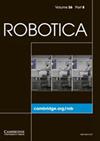Online pattern recognition of lower limb movements based on sEMG signals and its application in real-time rehabilitation training
IF 2.7
4区 计算机科学
Q3 ROBOTICS
引用次数: 0
Abstract
Abstract An online pattern recognition method of lower limb movements is proposed based on the personalized surface electromyography (sEMG) signals, and the corresponding experimental researches are performed in the rehabilitation training. Further, a wireless wearable acquisition instrument is used. Based on this instrument, a host computer for the personal online recognition and real-time control of rehabilitation training is developed. Three time-domain features and two features in the nonlinear dynamics are selected as the joint set of the characteristic values for the sEMG signals. Then a particle swarm optimization (PSO) algorithm is used to optimize the feature channels, and a k-nearest neighbor (KNN) algorithm and the extreme learning machine (ELM) algorithm are combined to classify and recognize individual sample data. Based on the multi-pose lower limb rehabilitation robot, the real-time motion recognition and the corresponding rehabilitation training are carried out by using the online personalized classifier. The experimental results of eight subjects indicate that it takes only 6 min to build an online personalized classifier for the four types of the lower limb movements. The recognition between switches of different rehabilitation training movements is timely and accurate, with an average recognition accuracy of more than 95%. These results demonstrate that this system has a strong practicability.基于表面肌电信号的下肢运动在线模式识别及其在实时康复训练中的应用
摘要提出了一种基于个性化表面肌电信号的下肢运动在线模式识别方法,并在康复训练中进行了相应的实验研究。此外,还使用了无线可穿戴采集仪器。在此基础上,研制了用于康复训练个人在线识别和实时控制的上位机。选取三个时域特征和两个非线性动力学特征作为表面肌电信号特征值的联合集。然后利用粒子群算法(PSO)对特征通道进行优化,结合k近邻算法(KNN)和极限学习机算法(ELM)对单个样本数据进行分类识别。基于多姿态下肢康复机器人,利用在线个性化分类器进行实时运动识别和相应的康复训练。8名被试的实验结果表明,构建4种下肢运动类型的在线个性化分类器只需要6分钟。不同康复训练动作开关之间的识别及时准确,平均识别准确率在95%以上。结果表明,该系统具有较强的实用性。
本文章由计算机程序翻译,如有差异,请以英文原文为准。
求助全文
约1分钟内获得全文
求助全文
来源期刊

Robotica
工程技术-机器人学
CiteScore
4.50
自引率
22.20%
发文量
181
审稿时长
9.9 months
期刊介绍:
Robotica is a forum for the multidisciplinary subject of robotics and encourages developments, applications and research in this important field of automation and robotics with regard to industry, health, education and economic and social aspects of relevance. Coverage includes activities in hostile environments, applications in the service and manufacturing industries, biological robotics, dynamics and kinematics involved in robot design and uses, on-line robots, robot task planning, rehabilitation robotics, sensory perception, software in the widest sense, particularly in respect of programming languages and links with CAD/CAM systems, telerobotics and various other areas. In addition, interest is focused on various Artificial Intelligence topics of theoretical and practical interest.
 求助内容:
求助内容: 应助结果提醒方式:
应助结果提醒方式:


